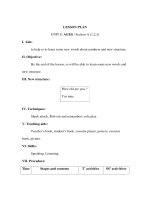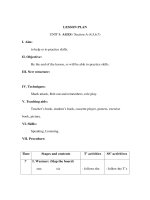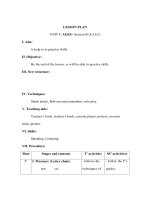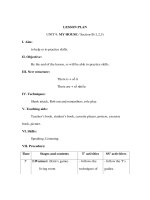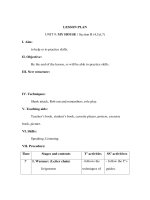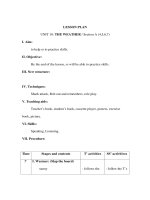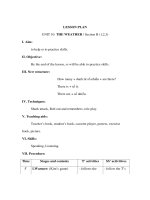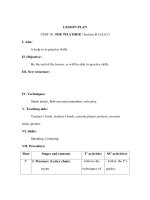- Trang chủ >>
- Mầm non - Tiểu học >>
- Lớp 5
GIÁO ÁN TIẾNG ANH LỚP 5
Bạn đang xem bản rút gọn của tài liệu. Xem và tải ngay bản đầy đủ của tài liệu tại đây (262.58 KB, 65 trang )
TuÇn 1
Monday, September 10th 2012
1st period
Unit one
A summer camping
Lesson one (T1)
A. Aims:
By the end of the lesson, Students will be able to remember names of the countries though
the flags.
Students will be able to ask and answer questions about where someone is from?
Students practice reading, writing, speaking.
Objectives: Cards of the flags.
B. Procedures:
I.Warm - up:
Set the scene to introduce the title of the lesson.
Do you know camping?
Have you ever been to a summer camp?
II. Presentation:
1. Vocabulary:
Teacher uses some flashcards of the flags to introduce the countries.
Malaysia
Thailand
The USA
Indonesia
Students read vocabulary after teacher
Students read in groups,Call three students read.
Checking vocabulary:
Rubout and remember
2. Look, listen and repeat.
+ Matching: Ask students to match.
A
B
Malaysia
New York
Thailand
Jakarta
The USA
Kuala Lumpur
Indonesia
Bangkok
Teacher checks and corrects. Students read after teacher. Call students read.
+ Set the scene:
Teacher introduces four characters for students.
---------------------------------------------------1
***----------------------------------------
Students look at the pictures at page 6 and listen to the teacher make model.
Students read after teacher. T – Ss, Ss – T, Ss – Ss, call some pairs of students read.
Ask students to listen to the cassette.
Call students translate into Vietnamese.
Model sentences:
- Where are you from?
Bạn đến từ đâu?
Im from Thailand.
Mình đến từ Thái Lan
Where is he from?
Cậu ấy đến từ đâu?
He is from Malaysia.
Câu ấy đến từ Malaysia
- Where in Thailand are you from? Bạn đến từ đâu ở Thái Lan?
Im from Bangkok.
Tôi đến từ Bangkok
III. Practice:
Point, ask and answer.
Ask students to look at the book.
Teacher set the scene.a. This is Zack. He’s from Kuala Lumpur, Malaysia.
Students read after teacher. ( a, b, c, d )
Teacher models:
Example: Zack/ Malaysia / Kuala Lumpur.
A: Where’s he from?
B: He’s from Malaysia.
A: Where in Malaysia is he from?
B: Kuala Lumpur.
T – Ss, Ss – T, Ss – Ss, Open pairs, Closed pairs.
IV. Production:
Practice freely.
Example:
T: Where are you from?
S1: I’m from Viet Nam.
T: Where’s in Viet Nam are you from?
S2: I’m from Ha Tinh.
T – Ss, Ss – T, Ss – Ss, Open pairs, Closed pairs.
============================= * * *==========================
Tuesday, September 11 th 2012
2nd period
Unit one
A summer camping
Lesson one (T2)
A. Aims:
---------------------------------------------------2
***----------------------------------------
By the end of the lesson, Students will be able to remember names of the countries though
the flags.
Students will be able to ask and answer questions about where someone is from?
Students practice listening, speaking.
Objectives: Cards of the flags.
B. Procedures:
I. Warm - up:
Teacher asks about Zack, Lawan, Sam, Azmi
Example: A: Where’s Zack from?
B: He’s from Malaysia.
A: Where in Malaysia is he from?
B: Kuala Lumpur.
Call students work in pairs.
Ask students ask answer about themselves.
II. Practice:
1, Listen and tick.
Ask students to look at the book at page 7.
Get students to look at the pictures and tell them the purpose of listening. You are going to
listen and tick the correct picture in each number.
Play the recording twice. Student listen and tick the picture they here.
Replay the recording for students to correct their answer in pairs. Then ask students to report
their answers to the class. Give students to listen again.
1. b
2. b.
3. a
4. c
2. Talk
Ask students to look at six pictures at page 7 and identify the names of the characters.
a. Lawan b. Zack c. Azmi d. Sam e. Akio f. a Vietnamese girl
Teacher models:
Example: a. A: Who’s she?
B: She’s Lawan.
A: Where’s she from?
B: She’s from Thailand.
A: Where in Thailand is she from?
B: She’s from Bangkok.
T – Ss, Ss – T, Ss – Ss, Open pairs, Closed pairs.
IV. Production:
Practice freely.
---------------------------------------------------3
***----------------------------------------
Example:
T: Where are you from?
S1: I’m from Viet Nam.
T: Where’s in Viet Nam are you from?
S2: I’m from Ha Tinh.
T – Ss, Ss – T, Ss – Ss, Open pairs, Closed pairs.
Wednesday, September 12 th 2012
3rd period
Unit one
A summer camping
Lesson two (T1)
A. Aims:
By the end of the lesson, Students will be able to:
- Pronounce correctly the sounds of the letters ese as in Vietnamese and those of
the letters ian as in indonesian.
Students practice listening, speaking.
Objectives: Cards.
B. Procedures:
I. Warm - up:
Teacher asks about Zack, Lawan, Sam, Azmi
Example: A: Where’s Zack from?
B: He’s from Malaysia.
A: Where in Malaysia is he from?
B: Kuala Lumpur.
Call students work in pairs.
Ask students ask answer about themselves.
II. Pre teach vocabulary:
Cultural show
Chơng trình văn hoá
Mask
mặt nạ
Model
mô hình
Twin towers
Tháp đôi
Students read vocabulary after teacher
Students read in groups,Call three students read.
Checking vocabulary:
Rubout and remember
III. Practice:
1, Listen and repeat.
Ask Ps to open their book on page 8. Stick the large – sized sheet of paper with this section
writen on it on the board.
Teacher read, ps listen. Pupils read after teacher.
---------------------------------------------------4
***----------------------------------------
Pupils read in groups. Call students read.
Students listen to the cassette.
2. Listen and reapeat together .
Ask Ps to open their book on page 8.
Set the scene:
Who’s she?
Where’s she from?
Where is she now?
What is she going to do?
Teacher read, ps listen. Pupils read after teacher.
Pupils read in groups. Call students read.
Students listen to the cassette.
3. Group and say aloud .
Ask Ps to open their book on page 8. Get them to look at the chart and the word box.
Pupils read the words after teacher. Read in groups. Call students read.
Set time and let Ps do the task independently.
Teacher checks and corrects.
Students read again the words.
III. Homework:
- Learn by heart the words.
- Do exercises part I: 1, 2, 3; Part II: 1, 2
Friday, September 14 th 2012
4th period
Unit one
A summer camping
Lesson two (T2)
A. Aims:
By the end of the lesson, Students will be able to listen and number the pictures in the order
they hear.
Students practice listening, speaking.
Objectives: Cards.
B. Procedures:
I. Warm - up:
Ask students ask answer about themselves.
---------------------------------------------------5
***----------------------------------------
Example:
A: Where are you from?
B: I’m from Malaysia.
A: Where in Malaysia are you from?
B: Kuala Lumpur.
Call students work in pairs.
II. Practice:
1, Listen and number.
Ask students to open their books on page 9. Tell students the purpose of listening. You are
going to listen the recoording and number the pictures.
Set the scene: How many pictures are there?
Look at picture a: What is this?
…………………………………..
Picture a: a robotic cat in Doraemon, one of the popular Japanese mangas.
Picture b: The Petronas Twin Tower in Malaysia.
Picture c: three Indonesia masks.
Picture d: Chinese lantern
- Play the recording twice. Students listen and do the task.
- Sharing and comparing.
Teacher checks and corrects.
Tapescripts: Tomorrow, there is a cutural activity at the summer camp. We’re going to
have some talks and a cultural display.
1. An Indonesian boy is going to show some Indonesian masks and talk about their history.
2. A Chinese girl is going to show a Chineses lantern and show how to make it.
3. A Malaysian boy is going to show a model of the Petronas Twin Tower and talk about the
building.
4. At the end, We’re going to watch a Japanese cartoon. A Japanese girl has got a video tape
of Doraemon to show. It’s going to be fun.
1. c
2. d
3. b
4 a
2. Fun time:
City Bingo
London
Sydney
Ha Noi
Tokyo
Kuala
Lumpur
New York
Bangkok
Jakarta
Seoul
---------------------------------------------------6
***----------------------------------------
Ask students to draw the grid and write a list of the cities on the paper.
Students repeat the names of the cities after teacher.
Teacher call the city names at random and tell Ss cross the names they hear.
The first Ss who crosses out the three cities on any straight lines calls out “Bingo”
III. Homework:
- Learn by heart the words of the cities.
TuÇn 2
Monday, September 17th 2012
5th period
Unit one
A summer camping
Lesson three (T1)
A. Aims:
By the end of the lesson, Students will be able to ask and answer questions about someone’s
nationality.
Students will be able to ask and answer questions about where someone is from?
Students practice reading, writing, speaking.
Objectives: Cards of the characters.
B. Procedures:
I.Warm - up:
Ask students ask answer about themselves.
Example: A: Where are you from?
B: I’m from Viet Nam.
A: Where in Viet Nam are you from?
B: I’m from Hong Linh.
Call students work in pairs.
Ask students ask and answer about Sam, Zack, Linda, Tony, Azmi.
II. Pre teach vocabulary:
stage
sân khấu
nationality
quốc tịch
Students read vocabulary after teacher
Students read in groups,Call three students read.
Checking vocabulary:
Rubout and remember
III. Presentation::
---------------------------------------------------7
***----------------------------------------
1. Look, listen and repeat.
Set the scene: Picture a.
T: Who’s she?
Ss: She’s Lawan
T: Who’s he?
Ss: He’s Zack
T: Who’s he?
Ss: He’s Azmi
T: What are Lawan and Zack doing? They are talking about Azmi.
Teacher plays roles, Students listen. Students read after teacher. Hang the poster of the
dialogue on the board.
Teacher and students play roles, Students play roles and read. .
Call one student translate into Vietnamese.
Students look at the books and read after teacher. Call students read. Students play roles.
Set the scene: Picture b
T: Who’s she?
Ss: She’s Akio
T: Who’s she?
Ss: She’s Mai
T: Who’s he?
Ss: He’s Zack
T: What are Mai and Zack doing? They are talking about Akio.
Teacher plays roles, Students listen. Students read after teacher. Hang the poster of the
dialogue on the board.
Teacher and students play roles, Students play roles and read. .
Call one student translate into Vietnamese.
Model sentence:
What’s her nationality?
Qc tÞch cđa cô ấy là gì?
Shes Japanese.
Cô ấy là ngời Nhật.
Students look at the books and read after teacher. Call students read. Students play roles.
Note:
What’s her/ his nationality?
She’s / He’s + quèc tÞch ( Japanese, Chinese, American….)
III. Practice:
Point, ask and answer.
Ask students to open theis books at page 10 and read after teacher.
Teacher makes model.
Example: Akio / Japanese.
A:
What’s her nationality?
B:
She’s Japanese.
Students read after teacher.
T – Ss, Ss – T, Ss – Ss, open pairs, Closed pairs.
Example:
a. What’s his nationality?
---------------------------------------------------8
***----------------------------------------
He’s Vietnamese.
b. What’s his nationality?
He’s American.
IV. Production:
Ask students to practice freely.
Example:
S1:
What’s your nationality?
S2:
I’m Indonesian.
Complete the dialogue.
Nga:
………..are you from?
Nam:
I’m ………..Vietnam.
Nga:
What’s your ……………..
Nam:
I ………. Vietnamese.
Ask students to play roles.
V. Homework:
- Learn by heart vocabulary and structures.
- Do exercises III: 1, 2 .
- Prepare the part: Read and do the tasks.
============================* * *===========================
Tuesday, September 18th 2012
6th period
Unit one
A summer camping
Lesson three (T2)
A. Aims:
By the end of the lesson, Students will be able to ask and answer questions about someone’s
nationality.
Students will be able to read an information text on a summer camp and write an
email.
Students practice reading, writing, speaking.
Objectives: poster.
B. Procedures:
I.Warm - up:
Teacher asks some students.
Example: A: Where are you from?
B: I’m from Viet Nam.
---------------------------------------------------9
***----------------------------------------
A: What’s your nationality?
B: I’m Vietnamese.
Call students work in pairs.
Ask students ask and answer about Sam, Zack, Linda, Tony, Azmi
Example: A: Where is Zack from?
B: He’s from Malaysia.
A: What’s his nationality?
B: He’s Malaysian.
II. Pre – teach vocabulary:
Go hiking
®i leo nói
National Park
Công viên Quốc gia
Tell - tolk
kể
Sing sang
Dance - danced
Wonderful
tuyệt vêi
Students read vocabulary after teacher
Students read in groups,Call three students read.
Checking vocabulary:
Rubout and remember
II. Practice:
1. Read and do the tasks.
a. Tick T (true) or F (false)
Ask students to open their book at page 11, and read the test, then do the task.
Sharing and comparing. Teacher checks and corrects.
Call students read the text again.
b. Discuss with a parter.
1. Read and write an e-mail.
Ask students to read the letter and write an e-mail.
Sharing and comparing.Teacher checks and corrects.
III. Production:
1. Fun time:
Sing and guess the friends’s names.
Ask students to look at the pictures at page 12.
Ask students to identify the fcharacters in the pictures..
Play the recording through for students to listen.
Play the recording again for the students to listen and sing along.
Divide the class into groups. Each group sings a line without music.
Students practice singing in groups, doing actions.
Call on a group to sing the song in front of the class. The rest of the class clap to the beat.
---------------------------------------------------10
***----------------------------------------
IV. Homework:
- Learn by heart the song.
- Do exercises at page 7,8
Wednesday, September 19 th 2012
7th period
Unit two My friend’s house
Lesson one (T1)
A. Aims:
By the end of the lesson, Students will be able to ask and answer questions about where
someone lives.
Students will be able to remember the words: road, Avenue, lane, block of flat, floor.
Students practice reading, speaking, listening.
Objectives: poster.
B. Procedures:
I.Warm - up:
Teacher checks and corrects homework for students in work book.
II. Pre teach vocabulary:
street
đờng phố
tower
tháp
the same area
cùng khu phố
address.
địa chỉ
floor
tầng
fifty two
52
sixty one
61
Students read vocabulary after teacher
Students read in groups, Call three students read.
Checking vocabulary:
Rubout and remember
III. Presentation:
1. Look, listen and repeat.
Set the scene: Picture .
T: Who’s she?
Ss: She’s Mai
T: Who’s he?
Ss: He’s Tony ………..
T: What are they doing? They are talking about Azmi.
---------------------------------------------------11
***----------------------------------------
Teacher plays roles, Students listen. Students read after teacher. Hang the poster of the
dialogue on the board.
Teacher and students play roles, Students play roles and read. .
Call one student translate into Vietnamese.
Model sentence:
+ Where do you live?
Bạn sống ở đâu?
I live at 52 Ba Trieu Street..
T«i sèng ë sè 52 đờng Bà Triệu.
+ Where does she live?
Cô ấy sống ở đâu?
She lives at 61 Hai Ba Trung Street. Cô ấy sống ở số 61 đờng Hai Bà Trng.
Students look at the books and read after teacher. Call students read. Students play roles.
Note: Where do you live?
I live at 52 Ba Trieu Street.
I live on the second floor of Ha Noi Tower.
Where does she / he live? She/ He lives at / on……………….
IV. Practice:
1. Point, ask and answer.
Ask students to open their book at page 13. Set up the context.
We’re going to practuce asking and answering about addresses.
Student read the Example afer teacher.
T – Ss, Ss – T, Ss – Ss, open pairs, Closed pairs.
Teacher hang the poster on the board. Students read the words after teacher.
74 South Road
sè 74 dêng phía Nam
51 Green Avenue
số 51 Đại nội Xanh
72 Hoa Binh Lane
số 72 ngõ Hoà Bình
Thanh Cong Block of flats
Chung c Thành Công
Teacher makes model, Students listen.
Example: S1: Where do you live?
S2: I live at 74 South Road.
T – Ss, Ss – T, Ss – Ss, open pairs, Closed pairs.
V. FUrther practice:
Teacher asks some students about their addresses.
Example:
T: Where do you live?
S1: I live at 20 Phan Anh Street.
T: Where do you live?
S2: I live in Hong Linh.
Vi. Homework:
Lear by heart vocabulary, structures.
Practice asking and answering about addresses.
---------------------------------------------------12
***----------------------------------------
=========================* * *============================
Thursday, September 20th 2012
8th period
Unit two My friend’s house
Lesson one (T2)
A. Aims:
By the end of the lesson, Students will be able to ask and answer questions about where
someone lives.
Students will be able to remember again the words: road, Avenue, lane, block of flat,
floor…….
Students practice speaking, listening.
Objectives: poster.
B. Procedures:
I.Warm - up:
Role Play
Teacher prepares cards.
at 61 Hai Ba Trung Street.
52 Ba Trieu Street..
74 South Road
51 Green Avenue
72 Hoa Binh Lane
Thanh Cong Block of flats
Example: S1: Where do you live?
S2:
I live at 52 Ba Trieu Street.
T – Ss, Ss – T, Ss – Ss, open pairs, Closed pairs.
Teacher asks some students about their addresses.
Example:
T: Where do you live?
S1: I live at 20 Phan Anh Street
Open pairs.
II. Practice:
1. Listen and match:
Ask students to open their books at page 14. Tell them the listening purpose:
“ You are going to listen and match the boy / girl to his/ her address.
Ask students to look at the characters mand identify them.And ask students to identify the
addresses.
38 Park Village
52 South Street
26 High Street.
73 Green Street
Play the recording through for students to listen and do the task.
---------------------------------------------------13
***----------------------------------------
Play the recording again for the students to listen and checks.
Sharing and comparing.
Teacher checks and corrects.
Tapescripts:
Kate lives in a small town. She has got some classmates: Alex, Jim, Paul and Jenny. Now
she is talking about their address.
1. Hi, my name is Kate. I live in a small town. Alex, Jim, Paul and Jenny are my
classmates.
Alex lives in my area. He lives at 52 South Street
2. Jenny also lives in my area. She lives at 26 High Street.
3. Jim does not live in my area. He lives a73 Green Street
4. And Paul does not live in the city. He lives at 38 Park Village.
1 b 2c
3 d 4a
2. Talk.
Ask students to open their books at page 14.
Ask students to look at the characters and identify them and their location.
Quan: Tran Phu Street.
Linda 73 Rose Avenue
Mary: 98 Hill Road
Tony: 74 Spring Lane
Phong: 82 Hong Ha Street.
Then ask them to work in pairs.
Example: S1: What’s his name?
S2: His name’s Quan.
S1: Where does he live?
S2: He lives on Tran Phu Street.
T – Ss, Ss – T, Ss – Ss, open pairs, Closed pairs.
III. FUrther practice:
Teacher asks some students about their addresses.
Example:
T: Where do you live?
S1: I live at 20 Phan Anh Street.
T: Where do you live?
S2: I live in Hong Linh.
Vi. Homework:
Learn by heart vocabulary, structures.
Practice asking and answering about addresses.
---------------------------------------------------14
***----------------------------------------
TuÇn 3
Monday, September 24th 2012
9th period
Unit two My friend’s house
Lesson two (T1)
A. Aims:
By the end of the lesson, Students will be able to pronounce correctly the sound of the
lettersfl as inflat and bl as in block,
Students practice speaking, listening.
Objectives: poster.
B. Procedures:
I.Warm - up:
Teacher asks some students about their addresses.
Example:
T: Where do you live?
S1: I live at 20 Phan Anh Street.
T: Where do you live?
S2: I live in Hong Linh.
II. Practice:
1, Listen and repeat.
Ask Ps to open their book on page 15. Stick the large – sized sheet of paper with this section
writen on it on the board.
Teacher read, ps listen. Pupils read after teacher.
Pupils read in groups. Call students read.
Students listen to the cassette.
2. Listen and read together .
Ask Ps to open their book on page 15.
Set the scene:
Teacher read, ps listen. Pupils read after teacher.
Pupils read in groups. Call students read.
Students listen to the cassette.
3. Listen, complete and say aloud.
Ask Ps to open their book on page 15.
Set time and let Ps do the task independently.
Sharing and comparing.
Students listen to the cassette.
---------------------------------------------------15
***----------------------------------------
Teacher checks and corrects.
Students read again the words.
1. flat
2. black
3. blue
4. fly
5. blouse
6. block
7. flamingo
8. flower
III. Homework:
Do exercises pages 9, 10,11, 12.
=========================* * *==========================
Tuesday, September 25th 2012
10th period
Unit two My friend’s house
Lesson two (T2)
A. Aims:
By the end of the lesson, Students will be able to listen and number the lesson in the order
they hear.
Students practice speaking, listening.
Objectives: poster.
B. Procedures:
I.Warm - up:
Teacher asks some students about their addresses.
Example:
T: Where do you live?
S1: I live at 20 Phan Anh Street.
T: Where do you live?
S2: I live in Hong Linh.
II. Practice:
1, Listen and number.
Ask students to look at the book at page 16.
Tell them that they are going to listen to and number the pictures in the order they hear.
Set the scene: Teacher asks: How many pictures? Ss: Four.
Ask students to identify the roads in the pictures.
Play the recording through for students to listen.
Play the recording again for the students to do the task.
Play the recording once more for students to check their answers.
Sharing and comparing.
Teacher checks and corrects.
a. 3
b. 1 c. 5 d. 2
e 4
---------------------------------------------------16
***----------------------------------------
III. Further practice:
Fun time:
Do the crosswords puzzle.
Ask studenst to do individually.
Sharing and comparing.
Teacher checks and corrects.
1. twenty
2. cottage
3. lane
5. town
6. red
7. gate
Ask students to read the words.
III. Homework:
Do exercises pages 13.
Prepare lesson three period one.
4.
8.
seventy
kitchen
Wednesday, September 26th 2012
11th period
Unit two My friend’s house
Lesson three (T1)
A. Aims:
By the end of the lesson, Students will be able to remember the structures: What’s your
house like? It’s (a big house). It’s got ( a small yard)...
Students practice speaking, listening.
Objectives: poster.
B. Procedures:
I. Warm - up: Teacher asks some students about their addresses.
Example:
T: Where do you live?
S1: I live at 20 Phan Anh Street.
T: Where do you live?
S2: I live in Hong Linh
II. Pre – teach vocabulary:
balcony
ban công
gate
cổng
pond
vũng nớc,ao
roof
mái nhà
large
rộng
Students read vocabulary after teacher
Students read in groups, Call three students read.
Checking vocabulary:
Rubout and remember
---------------------------------------------------17
***----------------------------------------
III. Presentation:
2. Look, listen and repeat.
Set the scene: Picture .
T: Who’s she?
Ss: She’s Mai
T: Who’s he?
Ss: He’s Mr Loc
T: What are they doing? They are talking.
Teacher plays roles, Students listen. Students read after teacher. Hang the poster of the
dialogue on the board.
Teacher and students play roles, Students play roles and read. .
Call one student translate into Vietnamese.
Model sentence:
+ What’s your house like?
Nhà của bạn nh thế nào?
Its a big house.
Đó là một ngôi nhà nhỏ.
Its got a green gate.
Nó có cái cổng màu xanh.
Students look at the books and read after teacher. Call students read. Students play roles.
Note: + What’s your house like?
It’s a big house. It’s got a green gate.
IV. Practice:1. Point, ask and answer.
Ask students to open their book at page 17. Set up the context.
We’re going to practuce asking and answering about a friend’s house..
Student read the Example after teacher.
T – Ss, Ss – T, Ss – Ss, open pairs, Closed pairs.
Teacher hang the poster on the board. Students read the words after teacher.
Teacher makes model, Students listen.
Example: S1: What’s your house like?
S2: It’s a small flat. It’s got a small balcony.
T – Ss, Ss – T, Ss – Ss, open pairs, Closed pairs.
V. FUrther practice:
Teacher asks some students about their friends’ house.
Vi. Homework:
Learn by heart vocabulary, structures.
Practice asking and answering about their friends’ house.
.
Friday, September 28th 2012
12th period
Unit two My friend’s house
Lesson three (T2)
A. Aims:
---------------------------------------------------18
***----------------------------------------
By the end of the lesson, Students will be able to remember again the structures: What’s your
house like? It’s (a big house). It’s got ( a small yard)...
Students read a house disciption.
Students practice speaking, listening.
Objectives: poster.
B. Procedures:
I. Warm - up:
Teacher asks some students about their houses.
Example: S1: What’s your house like?
S2: It’s a small flat. It’s got a small balcony.
II. Practice:
1. Read and tick the right picture.
Ask students to open their book at page 18, and read the test, then do the task.
Sharing and comparing. Teacher checks and corrects.
Call students read the text again.
2. Read and write your friend’s house.
Ask students to readand complete the passage.
Sharing and comparing.Teacher checks and corrects.
III. Production:
1. Fun time:
Draw your house then colour it.
IV. Homework:
Learn by heart vocabulary, structures.
Practice asking and answering about their friends’ house.
TuÇn 4
Monday, October 1 st 2012
13th period
Unit three A birthday party
Lesson one (T1)
A. Aims:
By the end of the lesson, Students will be able to ask and answer questions about a
birthday present.
Students will be able to remember again the words: dictionary, comic book, paint, paint
brush, jigsaw puzzle, coloured balloon.
Students practice speaking, listening.
Objectives: poster.
B. Procedures:
I. Warm - up:
---------------------------------------------------19
***----------------------------------------
Teacher asks some students about their houses.
Example: S1: What’s your house like?
S2: It’s a small flat. It’s got a small balcony
II. Pre teach vocabulary:
dictionary
từ điển
comic book
truyện tranh
paint
sơn
paint brush
bút vẽ
jigsaw puzzle
bộ ghép hình
coloured balloon
bóng bay có màu
Students read vocabulary after teacher
Students read in groups, Call three students read.
Checking vocabulary:
Rubout and remember
III. Presentation:
3. Look, listen and repeat.
Set the scene: Picture .
T: Who’s she?
Ss: She’s Mai
T: Who’s he?
Ss: He’s Peter
T: Who’s he?
Ss: He’s Nam
T: What are they doing? They are talking.
Teacher plays roles, Students listen. Students read after teacher. Hang the poster of the
dialogue on the board.
Teacher and students play roles, Students play roles and read. .
Call one student translate into Vietnamese.
Model sentence:
+ What present did you give Mai?
Bạn đà tặng Mai quà gì?
A pink clock.
Một chiếc đồng hồ màu tím.
Students look at the books and read after teacher. Call students read. Students play roles.
Note: + What present did you give Mai?
A pink clock.
IV. Practice:
1. Point, ask and answer.
Ask students to open their book at page 20. Set up the context.
Students read the cue words after teacher.
Student read the Example after teacher.
T – Ss, Ss – T, Ss – Ss, open pairs, Closed pairs.
Teacher hang the poster on the board. Students read the words after teacher.
---------------------------------------------------20
***----------------------------------------
Teacher makes model, Students listen.
Example: S1: What present did you give Tony?
S2: A birthday card.
T – Ss, Ss – T, Ss – Ss, open pairs, Closed pairs.
V. FUrther practice:
Teacher asks some students.
Example:
T: What present did you give Tony?
S1: A birthday card.
Vi. Homework:
Learn by heart vocabulary, structures.
Practice asking and answering at the part 2 page 20.
============================* * *===========================
Tuesday, October 2nd 2012
14th period
Unit three A birthday party
Lesson one (T2)
A. Aims:
By the end of the lesson, Students will be able to ask and answer questions about a
birthday present.
Students listen the dialogues and tick the pictures they hear.
Students practice speaking, listening.
Objectives: poster.
B. Procedures:
I. Warm - up:
Teacher asks some students.
Example:
T: What present did you give Tony?
S1: A birthday card.
Ask studenst to work in pairs.
II. Practice:
1, Listen and tick.
Ask students to look at the book at page 21.
Tell them that they are going to listen to and tick the pictures they hear.
Set the scene: Teacher asks: How many pictures? Ss: nine.
Ask students to identify the each picture.
1. a. computer
b. a birthday card
c. a box of jigsaw puzzle
2. a. a boy with a birthday cake
b. a boy doing his homework.
c. a boy visiting his grandfather in the hospital.
---------------------------------------------------21
***----------------------------------------
3. a blue clock
b. a pink clock
c. a yellow clock
Play the recording through for students to listen.
Play the recording again for the students to do the task.
Play the recording once more for students to check their answers.
Sharing and comparing.
Teacher checks and corrects.
1. c
2. c
3. a
III. Further practice
1, Talk.
Set the scene and make model for students to understand.
Example:
T: Whose birthday party was it?
Ss: Mai’s birthday party.
T:
Did you go to Mai’s birthday party?
Ss: Yes, I did.
T:
What present did you give her?
Ss A blue clock.
T: What did you do at the party?
Ss: I danced, sang songs and played games.
T: Was it fun?
Ss; Yes, very much.
IV. Homework:
Learn by heart vocabulary, structures.
Practice asking and answering at the part 2 page 21.
Wednesday, October 3rd 2nd 2012
15th period
Unit three A birthday party
Lesson two (T1)
A. Aims:
By the end of the lesson, Students will be able to:
- Pronounce correctly the sounds of the letters ir as in third and those of the
letters em as in December.
Students practice listening, speaking.
Objectives: Cards.
B. Procedures:
I. Warm - up:
---------------------------------------------------22
***----------------------------------------
Teacher asks some students.
Example:
T: What present did you give Tony?
S1: A birthday card.
Ask studenst to work in pairs.
II. Practice:
1, Listen and repeat.
Ask Ps to open their book on page 22. Stick the large – sized sheet of paper with this section
writen on it on the board.
Teacher read, ps listen. Pupils read after teacher.
Pupils read in groups. Call students read.
Students listen to the cassette.
2. Listen and reapeat together .
Ask Ps to open their book on page 22.
Teacher read, ps listen. Pupils read after teacher.
Pupils read in groups. Call students read.
Students listen to the cassette.
3. Group and say aloud .
Ask Ps to open their book on page 22. Get them to look at the chart and the word box.
Pupils read the words after teacher. Read in groups. Call students read.
Set time and let Ps do the task independently.
Teacher checks and corrects.
Students read again the words.
III. Homework:
- Learn by heart the words.
- Do exercises part I: 1, 2, 3; Part II: 1, 2
===========================* * * ============================
Friday, October 4th 2012
16h period
Unit three A birthday party
Lesson two (T2)
A. Aims:
By the end of the lesson, Students will be able to listen and number the pictures in the order
they hear.
Students practice listening, speaking.
Objectives: Cards.
B. Procedures:
I. Warm - up:
---------------------------------------------------23
***----------------------------------------
Teacher asks some students.
Example:
T: What present did you give Tony?
S1: A birthday card.
Ask studenst to work in pairs.
II. Practice:
1, Listen and number.
Ask students to open their books on page 23. Tell students the purpose of listening. You are
going to listen the recording and number the pictures.
Set the scene: How many pictures are there?
Look at picture a: What is this?
…………………………………..
a. a big beach ball b. a dictionary c. a robot d. a box of coloured pencils.
Play the recording twice. Students listen and do the task.
Sharing and comparing.
Teacher checks and corrects.
2. Fun time:
Teacher guides for students to understand.
Teacher introduces the words: turn on, turn off the light, silkycute kitten
Ask studenst to read the text.
Hang the frame of the dialogue on the board.
Linda: (give Nam a box): Happy birthday to you, Nam.
Nam: Gets the box from Linda): Thank you, Linda. What is it?
Linda: Turn off the lights before you open it.
Nam: Oh! There’s something soft and silky. Oh, it’s warm and it is touching me. Ugh!
T – Ss, Ss – T, Ss – Ss, Open pairs, Closed pairs.
Call some pairs of studenst to perform in fron of the class.
III. Further practice
Role play
IV. Homework:
Learn by heart vocabulary, structures.
Do exercises page 14, 15,16, 17.
TuÇn 5
Monday, October 8 th 2012
17th period
Unit three A birthday party
---------------------------------------------------24
***----------------------------------------
Lesson three (T1)
A. Aims:
By the end of the lesson, Students will be able to ask and answer questions about what
one did at a birthday party.
Students will be able to remember the words: play hide – and seek, chat with friends, watch
some cartoons.
Students practice speaking, listening.
Objectives: poster.
B. Procedures:
I. Warm - up:
Teacher asks some students.
Example:
T: What present did you give Tony?
S1: A birthday card.
Ask studenst to work in pairs.
II. Pre – teach vocabulary:
Play hide- and seek
chơi trốn tìm
Chat with friends
nói chuyện với bạn
Watch some cartoons
xem phim hoạt hình
Students read vocabulary after teacher
Students read in groups, Call three students read.
Checking vocabulary:
Rubout and remember
III. Presentation:
4. Look, listen and repeat.
Set the scene: Picture .
T: Who’s she?
Ss: She’s Hoa
T: Who’s he?
Ss: He’s Nam
T: What are they doing? They are talking.
Nam went to Tony’s birthday. Now his sister Hoa is asking him what they did at the party.
Teacher plays roles, Students listen. Students read after teacher. Hang the poster of the
dialogue on the board.
Teacher and students play roles, Students play roles and read. .
Call one student translate into Vietnamese.
Model sentence:
+ What did you do at the party?
C¸c bạn đà làm gì ở bữa tiệc?
We played hide and seek..
Chúng tôi chơi trò trốn tìm.
Students look at the books and read after teacher. Call students read. Students play roles.
Note: + What did you do at the party?
---------------------------------------------------25
***----------------------------------------

